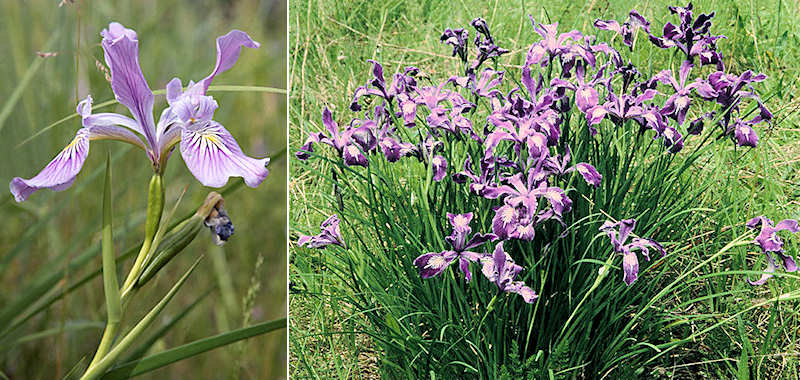Wild PCN iris - short tube group (3 species), spathes spreading:
10. Tough-leaf iris (Oregon iris) - Iris tenax

Oregon Iris: (L) Hagg Lake, Oregon 2006 Trek, by Kenneth Walker; (R) Roseburg, Oregon 1997 Trek, by Elyse Hill
(Both photos from SPCNI Promotional CD, May 2009).

Range: Common and widespread in most of western Oregon and southwest Washington west of the Cascade Mountains. There is a small separate population in northern California's Klamath Mountains.
Original material: Seeds sent to England by explorer-naturalist David Douglas 1825
Key identifying features:
- Floral tube between ovary and petals stout and very short (about ¼ inch) .
- Narrow spathes separate, leaving ovary exposed; lower spathe often set off from stalk at a sharp angle.
- Style crests short and rounded.
- Stalks usually bear a single flower, occasionally two.
- Plants form dense, compact clumps, with narrow, light green leaves.
Flower color: Wide color range from purple and lavender (near the Cascades), maroon or pink (southwest Washington and northwest Oregon), and pale blue to yellow, cream and white.
Habitat: Open or lightly shaded sites in open oak woodlands; unusual in coniferous forests except along the edges or where they have been logged over.
Name: By the British botanist John Lindley, from David Douglas' notes that local Indians used the tough ("tenax") leaf fibers as strong cordage to make nets, rope and snares.
Comments: This is the Pacific Coast native iris that most deserves a common name of "rainbow iris". Plants showing a wide range of colors can sometimes be found on a single small hillside. Before its extensive color gamut was well recognized, a yellow-flowered variety from the region of Henry Hagg Lake in northern Oregon was described as a separate species - Iris gormanii.
Wild tough-leaf iris forms large, attractive clumps. The species' cold hardiness could prove useful to hybridizers trying to develop attractive Pacifica strains that grow more easily in cooler regions elsewhere. Where their ranges overlap, I. tenax produces natural hybrids with I. douglasiana, I. chrysophylla, I. innominata, and in California probably with Iris tenuissima.
California's "Orleans Iris" comprises a small, isolated population along the Klamath River near the town of Orleans in Humboldt County. It was described in 1958 as a distinct subspecies - I. tenax klamathensis. The funnel-shaped floral tube is longer (around ½ to ¾ inch), flower color is limited to pale cream or light yellow with a yellow eye spot on the petals and reddish-brown veins, and it lives in more shaded habitats than the I. tenax populations farther north.
Additional Photos:
- Strong cordage from Iris tenax leaves made by Sara "Weaver Mama"
- Iris tenax color palette - the real Pacifica "Rainbow Iris"?
- Iris tenax - Rita Gormley: The 2006 SPCNI Trek to Hagg Lake, Oregon (PDF format)
- The Orleans Iris I. tenax klamathensis - in Humboldt County, California
- Saddle Mountain Park, Oregon - June 2009. Photo by Kathleen Sayce